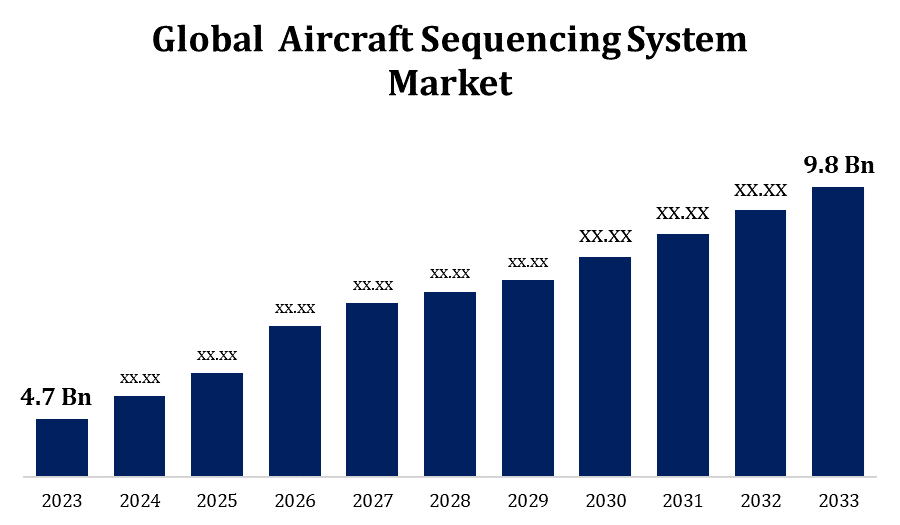Global Aircraft Sequencing System Market Size, Share, and COVID-19 Impact Analysis, By Type (Software, Services), By Application (Commercial and Civil, Military), and By Region (North America, Europe, Asia-Pacific, Latin America, Middle East, and Africa), Analysis and Forecast 2023 - 2033
Industry: Aerospace & DefenseGlobal Aircraft Sequencing System Market Size Insights Forecasts to 2033
- The Aircraft Sequencing System Market Size was valued at USD 4.7 Billion in 2023.
- The market is growing at a CAGR of 7.62% from 2023 to 2033
- The global Aircraft Sequencing System Market is expected to reach USD 9.8 Billion by 2033
- Asia Pacific is expected to grow the fastest during the forecast period

Get more details on this report -
The global Aircraft Sequencing System Market is expected to reach USD 9.8 billion by 2033, at a CAGR of 7.62% during the forecast period 2023 to 2033.
The Aircraft Sequencing System market is experiencing steady growth, driven by the increasing demand for efficient air traffic management due to rising global air travel. These systems play a critical role in optimizing the sequencing and spacing of aircraft, enhancing safety, reducing delays, and improving overall airport efficiency. As airports and air traffic control systems face growing pressure to handle more flights, the adoption of advanced sequencing technologies is becoming essential. The market is further fueled by the integration of AI and machine learning, enabling more precise and dynamic sequencing decisions. Additionally, the push for sustainable aviation practices, including fuel efficiency and reduced emissions, is driving investments in these systems. The market is set to expand as the aviation industry continues to modernize its infrastructure.
Aircraft Sequencing System Market Value Chain Analysis
The Aircraft Sequencing System market value chain involves several key stages, beginning with the development and procurement of advanced software and hardware components. These include algorithms, sensors, communication systems, and user interfaces, sourced from specialized technology providers. Next, system integrators combine these components into comprehensive sequencing solutions tailored for airports and air traffic control centers. The deployment phase involves close collaboration with aviation authorities to ensure seamless integration into existing air traffic management systems. Post-deployment, ongoing support, maintenance, and software updates are crucial for optimizing system performance and adapting to evolving air traffic patterns. The value chain concludes with end-users, primarily air traffic controllers, who rely on these systems to enhance flight sequencing, reduce delays, and improve safety. Innovation and continuous improvement drive value throughout this chain.
Aircraft Sequencing System Market Opportunity Analysis
The Aircraft Sequencing System market offers significant growth opportunities driven by the increasing need for efficient air traffic management in response to rising global air travel. As airports and air traffic control centers face growing congestion, there is a strong demand for advanced sequencing systems that can optimize aircraft flow, reduce delays, and enhance safety. The integration of AI, machine learning, and predictive analytics into these systems presents opportunities for innovation, allowing for more accurate and dynamic sequencing decisions. Emerging markets, particularly in Asia-Pacific and the Middle East, are investing in new airports and air traffic infrastructure, creating a fertile ground for market expansion. Additionally, the push for greener aviation practices, emphasizing fuel efficiency and reduced emissions, further drives the adoption of these systems, amplifying market growth potential.
Global Aircraft Sequencing System Market Report Coverage
| Report Coverage | Details |
|---|---|
| Base Year: | 2023 |
| Market Size in 2023: | USD 4.7 Billion |
| Forecast Period: | 2023 - 2033 |
| Forecast Period CAGR 2023 - 2033 : | 7.62% |
| 2033 Value Projection: | USD 9.8 Billion |
| Historical Data for: | 2019-2022 |
| No. of Pages: | 241 |
| Tables, Charts & Figures: | 110 |
| Segments covered: | By Type, By Application, By Region |
| Companies covered:: | Harris, Thales Group, United Technologies (Collins Aerospace), Carlyle Group (ADB Safegate), Amadeus IT Group, ATRiCS, Eurocontrol, Transoft Solutions, and PASSUR Aerospace |
| Pitfalls & Challenges: | Covid 19 Impact Challanges, Future, Growth and Analysis |
Get more details on this report -
Market Dynamics
Aircraft Sequencing System Market Dynamics
Increased demand for cost-effective and reliable air traffic control systems
The growing demand for cost-effective and reliable air traffic control (ATC) systems is a key driver in the Aircraft Sequencing System market. As global air travel continues to expand, airports and air traffic management centers face increasing pressure to manage higher flight volumes efficiently without compromising safety. Cost-effective sequencing systems offer a solution by optimizing aircraft flow, reducing delays, and minimizing operational costs. These systems are particularly valuable for smaller and mid-sized airports that seek to enhance their capabilities within budget constraints. Additionally, the emphasis on reliability ensures that these systems can consistently manage complex air traffic scenarios, even during peak periods.
Restraints & Challenges
High initial costs and complex integration requirements can be barriers for airports, especially smaller ones, limiting widespread adoption. The need for seamless compatibility with existing air traffic management systems and legacy infrastructure adds further complexity to implementation. Additionally, ensuring real-time accuracy and reliability in diverse weather conditions and high-traffic scenarios presents technical challenges. The market also grapples with regulatory hurdles, as aviation authorities must rigorously evaluate and approve these systems, slowing down deployment. Cybersecurity concerns pose another challenge, with the increasing digitization of air traffic control systems requiring robust protection against potential threats.
Regional Forecasts
North America Market Statistics

Get more details on this report -
North America is anticipated to dominate the Aircraft Sequencing System Market from 2023 to 2033. The United States, with its extensive network of major airports and busy airspace, leads the demand for sophisticated sequencing systems that enhance air traffic management efficiency. The focus on improving airport capacity, reducing delays, and ensuring safety in increasingly congested skies propels market growth. Technological advancements, including AI and machine learning integration, are well-received in North America, where innovation in air traffic control is a priority. Additionally, the region's strong regulatory framework supports the adoption of cutting-edge systems.
Asia Pacific Market Statistics
Asia Pacific is witnessing the fastest market growth between 2023 to 2033. Developing nations are modernizing and expanding their airports to accommodate growing passenger volumes and improve air traffic management efficiency. This increased infrastructure development creates a strong demand for advanced sequencing systems to handle high traffic volumes and optimize flight scheduling. Additionally, the adoption of innovative technologies such as AI and machine learning in sequencing systems is gaining traction, offering enhanced precision and operational efficiency. As these countries continue to develop their aviation sectors, the need for cost-effective, reliable, and sophisticated sequencing solutions is expected to drive substantial market growth in the Asia-Pacific region.
Segmentation Analysis
Insights by Type
The software segment accounted for the largest market share over the forecast period 2023 to 2033. Modern sequencing systems rely heavily on software to process complex data, optimize aircraft flow, and ensure safe and efficient operations. Innovations such as AI, machine learning, and predictive analytics are enhancing software capabilities, allowing for more accurate and dynamic flight scheduling. The demand for real-time processing and improved decision-making tools fuels the need for advanced software solutions. Additionally, the growing emphasis on reducing delays and enhancing operational efficiency in busy airports further drives the adoption of sophisticated sequencing software. As the aviation industry continues to expand, the software segment is poised for continued growth, offering enhanced functionality and integration capabilities.
Insights by Application
The military aviation segment accounted for the largest market share over the forecast period 2023 to 2033. Military airbases and defense operations require specialized sequencing systems to handle diverse aircraft types, manage airspace efficiently, and ensure rapid response capabilities. The increasing modernization of military aviation infrastructure and the integration of sophisticated technologies such as AI and advanced radar systems are key factors contributing to this growth. Additionally, the focus on enhancing operational efficiency, safety, and mission effectiveness in military aviation drives demand for cutting-edge sequencing solutions. As defense budgets expand and military operations become more intricate, the need for reliable, high-performance sequencing systems in military aviation continues to grow.
Recent Market Developments
- In July 2020, Boeing has announced the creation of a new aircraft sequencing system that will increase efficiency and lower costs.
Competitive Landscape
Major players in the market
- Harris
- Thales Group
- United Technologies (Collins Aerospace)
- Carlyle Group (ADB Safegate)
- Amadeus IT Group
- ATRiCS
- Eurocontrol
- Transoft Solutions
- PASSUR Aerospace
Market Segmentation
This study forecasts revenue at global, regional, and country levels from 2023 to 2033.
Aircraft Sequencing System Market, Type Analysis
- Software
- Services
Aircraft Sequencing System Market, Application Analysis
- Commercial and Civil
- Military
Aircraft Sequencing System Market, Regional Analysis
- North America
- US
- Canada
- Mexico
- Europe
- Germany
- Uk
- France
- Italy
- Spain
- Russia
- Rest of Europe
- Asia Pacific
- China
- Japan
- India
- South Korea
- Australia
- Rest of Asia Pacific
- South America
- Brazil
- Argentina
- Rest of South America
- Middle East & Africa
- UAE
- Saudi Arabia
- Qatar
- South Africa
- Rest of the Middle East & Africa
Frequently Asked Questions (FAQ)
-
1. What is the market size of the Aircraft Sequencing System Market?The global Aircraft Sequencing System Market is expected to grow from USD 4.7 billion in 2023 to USD 9.8 billion by 2033, at a CAGR of 7.62% during the forecast period 2023-2033.
-
2. Who are the key market players of the Aircraft Sequencing System Market?Some of the key market players of the market are Harris, Thales Group, United Technologies (Collins Aerospace), Carlyle Group (ADB Safegate), Amadeus IT Group, ATRiCS, Eurocontrol, Transoft Solutions, PASSUR Aerospace.
-
3. Which segment holds the largest market share?The military aviation segment holds the largest market share and is going to continue its dominance.
-
4. Which region dominates the Aircraft Sequencing System Market?North America dominates the Aircraft Sequencing System Market and has the highest market share.
Need help to buy this report?